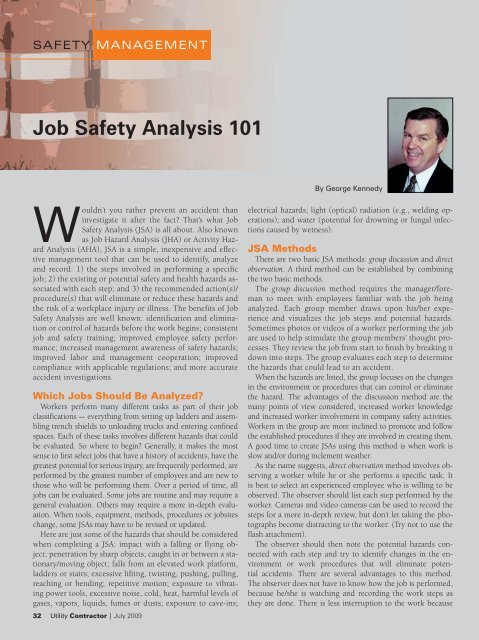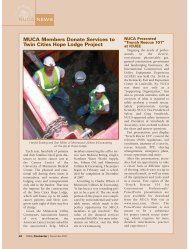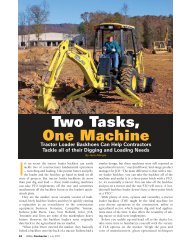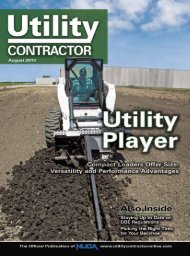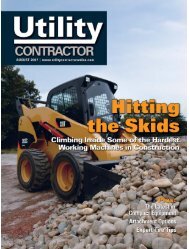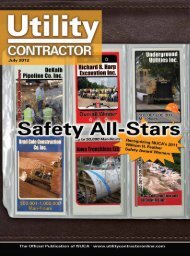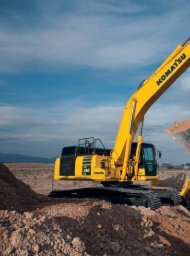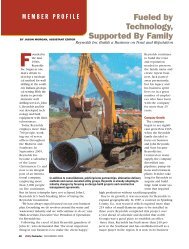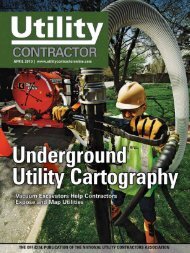View Full July PDF Issue - Utility Contractor Magazine
View Full July PDF Issue - Utility Contractor Magazine
View Full July PDF Issue - Utility Contractor Magazine
- No tags were found...
Create successful ePaper yourself
Turn your PDF publications into a flip-book with our unique Google optimized e-Paper software.
SAFETY MANAGEMENTJob Safety Analysis 101By George KennedyWouldn’t you rather prevent an accident thaninvestigate it after the fact? That’s what JobSafety Analysis (JSA) is all about. Also knownas Job Hazard Analysis (JHA) or Activity HazardAnalysis (AHA), JSA is a simple, inexpensive and effectivemanagement tool that can be used to identify, analyzeand record: 1) the steps involved in performing a specificjob; 2) the existing or potential safety and health hazards associatedwith each step; and 3) the recommended action(s)/procedure(s) that will eliminate or reduce these hazards andthe risk of a workplace injury or illness. The benefits of JobSafety Analysis are well known: identification and eliminationor control of hazards before the work begins; consistentjob and safety training; improved employee safety performance;increased management awareness of safety hazards;improved labor and management cooperation; improvedcompliance with applicable regulations; and more accurateaccident investigations.Which Jobs Should Be Analyzed?Workers perform many different tasks as part of their jobclassifications — everything from setting up ladders and assemblingtrench shields to unloading trucks and entering confinedspaces. Each of these tasks involves different hazards that couldbe evaluated. So where to begin? Generally, it makes the mostsense to first select jobs that have a history of accidents, have thegreatest potential for serious injury, are frequently performed, areperformed by the greatest number of employees and are new tothose who will be performing them. Over a period of time, alljobs can be evaluated. Some jobs are routine and may require ageneral evaluation. Others may require a more in-depth evaluation.When tools, equipment, methods, procedures or jobsiteschange, some JSAs may have to be revised or updated.Here are just some of the hazards that should be consideredwhen completing a JSA: impact with a falling or flying object;penetration by sharp objects; caught in or between a stationary/movingobject; falls from an elevated work platform,ladders or stairs; excessive lifting, twisting, pushing, pulling,reaching or bending; repetitive motion; exposure to vibratingpower tools, excessive noise, cold, heat, harmful levels ofgases, vapors, liquids, fumes or dusts; exposure to cave-ins;32 <strong>Utility</strong> <strong>Contractor</strong> | <strong>July</strong> 2009electrical hazards; light (optical) radiation (e.g., welding operations);and water (potential for drowning or fungal infectionscaused by wetness).JSA MethodsThere are two basic JSA methods: group discussion and directobservation. A third method can be established by combiningthe two basic methods.The group discussion method requires the manager/foremanto meet with employees familiar with the job beinganalyzed. Each group member draws upon his/her experienceand visualizes the job steps and potential hazards.Sometimes photos or videos of a worker performing the jobare used to help stimulate the group members’ thought processes.They review the job from start to finish by breaking itdown into steps. The group evaluates each step to determinethe hazards that could lead to an accident.When the hazards are listed, the group focuses on the changesin the environment or procedures that can control or eliminatethe hazard. The advantages of the discussion method are themany points of view considered, increased worker knowledgeand increased worker involvement in company safety activities.Workers in the group are more inclined to promote and followthe established procedures if they are involved in creating them.A good time to create JSAs using this method is when work isslow and/or during inclement weather.As the name suggests, direct observation method involves observinga worker while he or she performs a specific task. Itis best to select an experienced employee who is willing to beobserved. The observer should list each step performed by theworker. Cameras and video cameras can be used to record thesteps for a more in-depth review, but don’t let taking the photographsbecome distracting to the worker. (Try not to use theflash attachment).The observer should then note the potential hazards connectedwith each step and try to identify changes in the environmentor work procedures that will eliminate potentialaccidents. There are several advantages to this method.The observer does not have to know how the job is performed,because he/she is watching and recording the work steps asthey are done. There is less interruption to the work because


